Activated Carbons Derived from Teak Sawdust-Hydrochars for Efficient Removal of Methylene Blue, Copper, and Cadmium from Aqueous Solution
Abstract
- -
- The activated carbon samples were synthesized through a two-step process.
- -
- The hydrothermal carbonization resulted in rich oxygen-containing functional groups.
- -
- The activating agents were used with different weight ratios to synthesize the new adsorbents.
- -
- Heavy metals and dyes were used as the adsorbates to examine the adsorption capacity.
- -
- The potential adsorption mechanisms were discussed in depth.
| Nomenclature of Synthesized Activated Carbon | |
| WAC | Only high-temperature calcination without activation process |
| ACZ1075 | Weight ratio of ZnCl2 to HTC = 0.75:1.0 |
| ACZ1100 | Weight ratio of ZnCl2 to HTC = 1.0:1.0 |
| ACZ1125 | Weight ratio of ZnCl2 to HTC = 1.25:1.0 |
| ACZ1175 | Weight ratio of ZnCl2 to HTC = 1.75:1.0 |
| ACZ1200 | Weight ratio of ZnCl2 to HTC = 2.0:1.0 |
| ACK1075 | Weight ratio of K2CO3 to HTC = 0.75:1.0 |
| ACK1100 | Weight ratio of K2CO3 to HTC = 1.0:1.0 |
| ACK1125 | Weight ratio of K2CO3 to HTC = 1.25:1.0 |
| ACK1175 | Weight ratio of K2CO3 to HTC = 1.75:1.0 |
| ACK1200 | Weight ratio of K2CO3 to HTC = 2.0:1.0 |
1. Introduction
2. Materials and Methods
2.1. Chemicals and Activated Carbon Preparation
2.2. Sorbent Characterization
2.3. Sorption Experiment and Data Analysis
3. Results and Discussion
3.1. Characteristics of Sorbent Materials
3.2. Adsorption Capacity of MB, Cd(II), and Cu(II) by ACs
3.3. Comparison of Adsorption Mechanisms
4. Conclusions
Author Contributions
Funding
Acknowledgments
Conflicts of Interest
References
- Tian, F.; Wu, Z.; Chen, Q.; Yan, Y.; Cravotto, G.; Wu, Z. Microwave-induced crystallization of AC/TiO2 for improving the performance of rhodamine B dye degradation. Appl. Surf. Sci. 2015, 351, 104–112. [Google Scholar] [CrossRef]
- Kim, S.; Chu, K.H.; Al-Hamadani, Y.A.; Park, C.M.; Jang, M.; Kim, D.-H.; Yu, M.; Heo, J.; Yoon, Y. Removal of contaminants of emerging concern by membranes in water and wastewater: A review. Chem. Eng. J. 2018, 335, 896–914. [Google Scholar] [CrossRef]
- Tran, H.N.; Chao, H.-P.; You, S.-J. Activated carbons from golden shower upon different chemical activation methods: Synthesis and characterizations. Adsorpt. Sci. Technol. 2018, 36, 95–113. [Google Scholar] [CrossRef]
- Li, C.; Chen, G.; Sun, J.; Rao, J.; Han, Z.; Hu, Y.; Xing, W.; Zhang, C. Doping effect of phosphate in Bi2WO6 and universal improved photocatalytic activity for removing various pollutants in water. Appl. Catal. B Environ. 2016, 188, 39–47. [Google Scholar] [CrossRef]
- Chen, X.; Wu, Z.; Liu, D.; Gao, Z. Preparation of ZnO photocatalyst for the efficient and rapid photocatalytic degradation of azo dyes. Nanoscale Res. Lett. 2017, 12, 143. [Google Scholar] [CrossRef]
- Kumar, R.; Kumar, G.; Umar, A. ZnO nano-mushrooms for photocatalytic degradation of methyl orange. Mater. Lett. 2013, 97, 100–103. [Google Scholar] [CrossRef]
- Liang, R.; Jing, F.; Shen, L.; Qin, N.; Wu, L. MIL-53 (Fe) as a highly efficient bifunctional photocatalyst for the simultaneous reduction of Cr (VI) and oxidation of dyes. J. Hazard. Mater. 2015, 287, 364–372. [Google Scholar] [CrossRef]
- Liu, G.; Zhang, Y.; Xu, L.; Xu, B.; Li, F. A PW 12/Bi2WO6 composite photocatalyst for enhanced visible light photocatalytic degradation of organic dye pollutants. New J. Chem. 2019, 43, 3469–3475. [Google Scholar] [CrossRef]
- De Gisi, S.; Lofrano, G.; Grassi, M.; Notarnicola, M. Characteristics and adsorption capacities of low-cost sorbents for wastewater treatment: A review. Sustain. Mater. Technol. 2016, 9, 10–40. [Google Scholar] [CrossRef]
- Jung, C.; Park, J.; Lim, K.H.; Park, S.; Heo, J.; Her, N.; Oh, J.; Yun, S.; Yoon, Y. Adsorption of selected endocrine disrupting compounds and pharmaceuticals on activated biochars. J. Hazard. Mater. 2013, 263, 702–710. [Google Scholar] [CrossRef]
- Lima, E.C. Removal of emerging contaminants from the environment by adsorption. Ecotoxicol. Environ. Saf. 2018, 150, 1–17. [Google Scholar]
- Ren, X.; Chen, C.; Nagatsu, M.; Wang, X. Carbon nanotubes as adsorbents in environmental pollution management: A review. Chem. Eng. J. 2011, 170, 395–410. [Google Scholar] [CrossRef]
- Bhatnagar, A.; Anastopoulos, I. Adsorptive removal of bisphenol A (BPA) from aqueous solution: A review. Chemosphere 2017, 168, 885–902. [Google Scholar] [CrossRef]
- Tran, H.N.; Wang, Y.-F.; You, S.-J.; Chao, H.-P. Insights into the mechanism of cationic dye adsorption on activated charcoal: The importance of π–π interactions. Process Saf. Environ. Prot. 2017, 107, 168–180. [Google Scholar] [CrossRef]
- Tran, H.N.; You, S.-J.; Chao, H.-P. Fast and efficient adsorption of methylene green 5 on activated carbon prepared from new chemical activation method. J. Environ. Manag. 2017, 188, 322–336. [Google Scholar] [CrossRef]
- Huang, F.-C.; Lee, C.-K.; Han, Y.-L.; Chao, W.-C.; Chao, H.-P. Preparation of activated carbon using micro-nano carbon spheres through chemical activation. J. Taiwan Inst. Chem. Eng. 2014, 45, 2805–2812. [Google Scholar] [CrossRef]
- Güzel, F.; Sayğılı, H.; Sayğılı, G.A.; Koyuncu, F. Elimination of anionic dye by using nanoporous carbon prepared from an industrial biowaste. J. Mol. Liq. 2014, 194, 130–140. [Google Scholar] [CrossRef]
- Libra, J.A.; Ro, K.S.; Kammann, C.; Funke, A.; Berge, N.D.; Neubauer, Y.; Titirici, M.-M.; Fühner, C.; Bens, O.; Kern, J.; et al. Hydrothermal carbonization of biomass residuals: A comparative review of the chemistry, processes and applications of wet and dry pyrolysis. Biofuels 2011, 2, 71–106. [Google Scholar] [CrossRef]
- Pelekani, C.; Snoeyink, V.L. Competitive adsorption between atrazine and methylene blue on activated carbon: The importance of pore size distribution. Carbon 2000, 38, 1423–1436. [Google Scholar] [CrossRef]
- Sun, L.; Wan, S.; Luo, W. Biochars prepared from anaerobic digestion residue, palm bark, and eucalyptus for adsorption of cationic methylene blue dye: Characterization, equilibrium, and kinetic studies. Bioresour. Technol. 2013, 140, 406–413. [Google Scholar] [CrossRef]
- Xue, Y.; Gao, B.; Yao, Y.; Inyang, M.; Zhang, M.; Zimmerman, A.R.; Ro, K.S. Hydrogen peroxide modification enhances the ability of biochar (hydrochar) produced from hydrothermal carbonization of peanut hull to remove aqueous heavy metals: Batch and column tests. Chem. Eng. J. 2012, 200, 673–680. [Google Scholar] [CrossRef]
- Jagtoyen, M.; Thwaites, M.; Stencel, J.; McEnaney, B.; Derbyshire, F. Adsorbent carbon synthesis from coals by phosphoric acid activation. Carbon 1992, 30, 1089–1096. [Google Scholar] [CrossRef]
- Zhang, T.; Walawender, W.P.; Fan, L.; Fan, M.; Daugaard, D.; Brown, R. Preparation of activated carbon from forest and agricultural residues through CO2 activation. Chem. Eng. J. 2004, 105, 53–59. [Google Scholar] [CrossRef]
- Fang, J.; Zhan, L.; Ok, Y.S.; Gao, B. Minireview of potential applications of hydrochar derived from hydrothermal carbonization of biomass. J. Ind. Eng. Chem. 2018, 57, 15–21. [Google Scholar] [CrossRef]
- Sun, Y.; Gao, B.; Yao, Y.; Fang, J.; Zhang, M.; Zhou, Y.; Chen, H.; Yang, L. Effects of feedstock type, production method, and pyrolysis temperature on biochar and hydrochar properties. Chem. Eng. J. 2014, 240, 574–578. [Google Scholar] [CrossRef]
- Tran, H.N.; Lee, C.-K.; Nguyen, T.V.; Chao, H.-P. Saccharide-derived microporous spherical biochar prepared from hydrothermal carbonization and different pyrolysis temperatures: Synthesis, characterization, and application in water treatment. Environ. Technol. 2018, 39, 2747–2760. [Google Scholar] [CrossRef]
- Boehm, H.P. Chemical identification of surface groups. Adv. Catal. 1966, 16, 179–274. [Google Scholar]
- Tsechansky, L.; Graber, E.R. Methodological limitations to determining acidic groups at biochar surfaces via the Boehm titration. Carbon 2014, 66, 730–733. [Google Scholar] [CrossRef]
- Langmuir, I. The adsorption of gases on plane surfaces of glass, mica and platinum. J. Am. Chem. Soc. 1918, 40, 1361–1403. [Google Scholar] [CrossRef]
- Sajjadi, S.-A.; Mohammadzadeh, A.; Tran, H.N.; Anastopoulos, I.; Dotto, G.L.; Lopičić, Z.R.; Sivamani, S.; Rahmani-Sani, A.; Ivanets, A.; Hosseini-Bandegharaei, A. Efficient mercury removal from wastewater by pistachio wood wastes-derived activated carbon prepared by chemical activation using a novel activating agent. J. Environ. Manag. 2018, 223, 1001–1009. [Google Scholar] [CrossRef]
- Sajjadi, S.-A.; Meknati, A.; Lima, E.C.; Dotto, G.L.; Mendoza-Castillo, D.I.; Anastopoulos, I.; Alakhras, F.; Unuabonah, E.I.; Singh, P.; Hosseini-Bandegharaei, A. A novel route for preparation of chemically activated carbon from pistachio wood for highly efficient Pb (II) sorption. J. Environ. Manag. 2019, 236, 34–44. [Google Scholar] [CrossRef]
- Raymundo-Pinero, E.; Azais, P.; Cacciaguerra, T.; Cazorla-Amorós, D.; Linares-Solano, A.; Béguin, F. KOH and NaOH activation mechanisms of multiwalled carbon nanotubes with different structural organisation. Carbon 2005, 43, 786–795. [Google Scholar] [CrossRef]
- Bouhamed, F.; Elouear, Z.; Bouzid, J. Adsorptive removal of copper (II) from aqueous solutions on activated carbon prepared from Tunisian date stones: Equilibrium, kinetics and thermodynamics. J. Taiwan Inst. Chem. Eng. 2012, 43, 741–749. [Google Scholar] [CrossRef]
- Ozdemir, I.; Şahin, M.; Orhan, R.; Erdem, M. Preparation and characterization of activated carbon from grape stalk by zinc chloride activation. Fuel Process. Technol. 2014, 125, 200–206. [Google Scholar] [CrossRef]
- Anjum, H.; Johari, K.; Appusamy, A.; Gnanasundaram, N.; Thanabalan, M. Surface modification and characterization of carbonaceous adsorbents for the efficient removal of oil pollutants. J. Hazard. Mater. 2019, 379, 120673. [Google Scholar] [CrossRef]
- Tran, H.N.; You, S.-J.; Nguyen, T.V.; Chao, H.-P. Insight into the adsorption mechanism of cationic dye onto biosorbents derived from agricultural wastes. Chem. Eng. Commun. 2017, 204, 1020–1036. [Google Scholar] [CrossRef]
- Tran, H.N.; You, S.-J.; Chao, H.-P. Insight into adsorption mechanism of cationic dye onto agricultural residues-derived hydrochars: Negligible role of π-π interaction. Korean J. Chem. Eng. 2017, 34, 1708–1720. [Google Scholar] [CrossRef]
- Shim, J.-W.; Park, S.-J.; Ryu, S.-K. Effect of modification with HNO3 and NaOH on metal adsorption by pitch-based activated carbon fibers. Carbon 2001, 39, 1635–1642. [Google Scholar] [CrossRef]
- Sun, K.; Tang, J.; Gong, Y.; Zhang, H. Characterization of potassium hydroxide (KOH) modified hydrochars from different feedstocks for enhanced removal of heavy metals from water. Environ. Sci. Pollut. Res. 2015, 22, 16640–16651. [Google Scholar] [CrossRef]
- Islam, M.A.; Benhouria, A.; Asif, M.; Hameed, B.H. Methylene blue adsorption on factory-rejected tea activated carbon prepared by conjunction of hydrothermal carbonization and sodium hydroxide activation processes. J. Taiwan Inst. Chem. Eng. 2015, 52, 57–64. [Google Scholar] [CrossRef]
- Peláez-Cid, A.-A.; Herrera-González, A.-M.; Salazar-Villanueva, M.; Bautista-Hernández, A. Elimination of textile dyes using activated carbons prepared from vegetable residues and their characterization. J. Environ. Manag. 2016, 181, 269–278. [Google Scholar] [CrossRef]
- Islam, M.A.; Ahmed, M.J.; Khanday, W.A.; Asif, M.; Hameed, B.H. Mesoporous activated coconut shell-derived hydrochar prepared via hydrothermal carbonization-NaOH activation for methylene blue adsorption. J. Environ. Manag. 2017, 203, 237–244. [Google Scholar] [CrossRef]
- Qian, W.-C.; Luo, X.-P.; Wang, X.; Guo, M.; Li, B. Removal of methylene blue from aqueous solution by modified bamboo hydrochar. Ecotoxicol. Environ. Saf. 2018, 157, 300–306. [Google Scholar] [CrossRef]
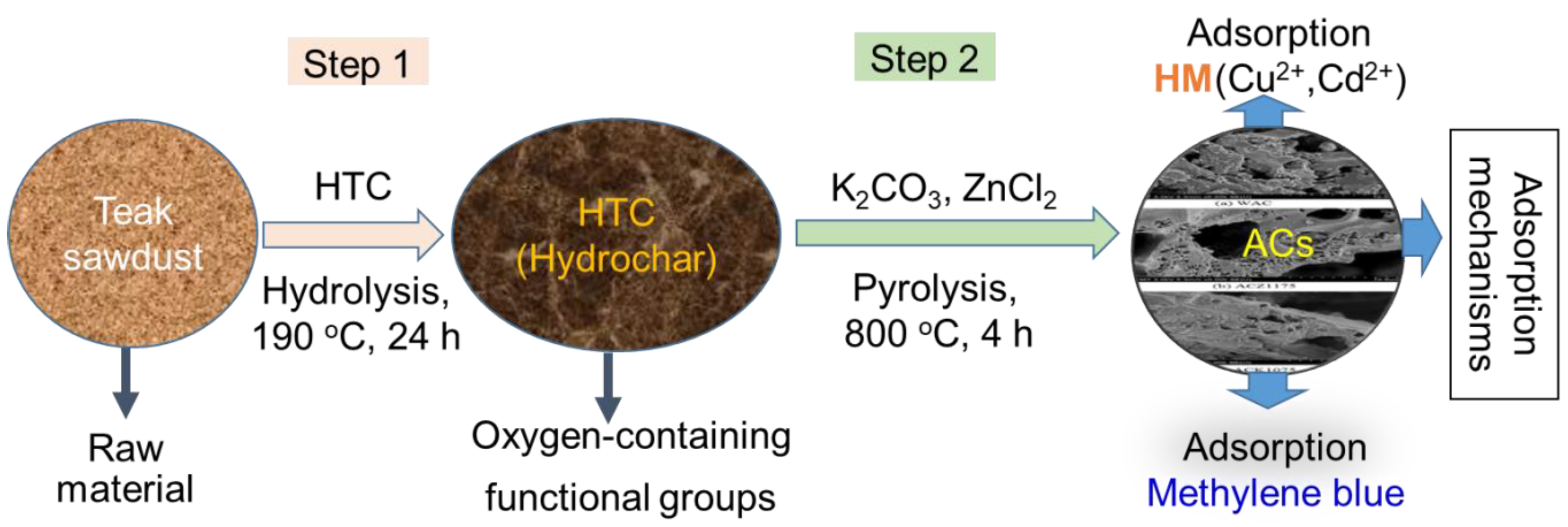
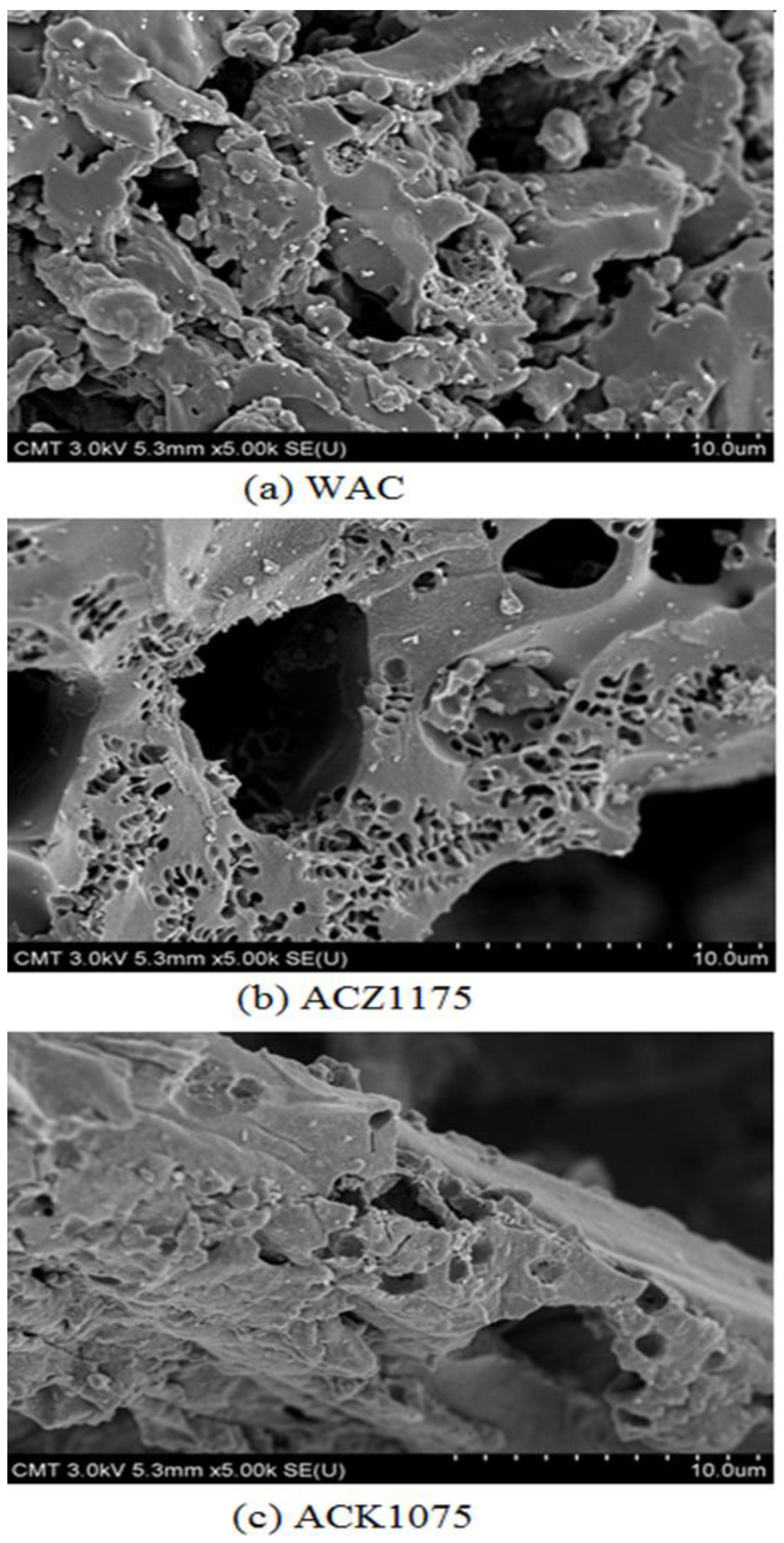
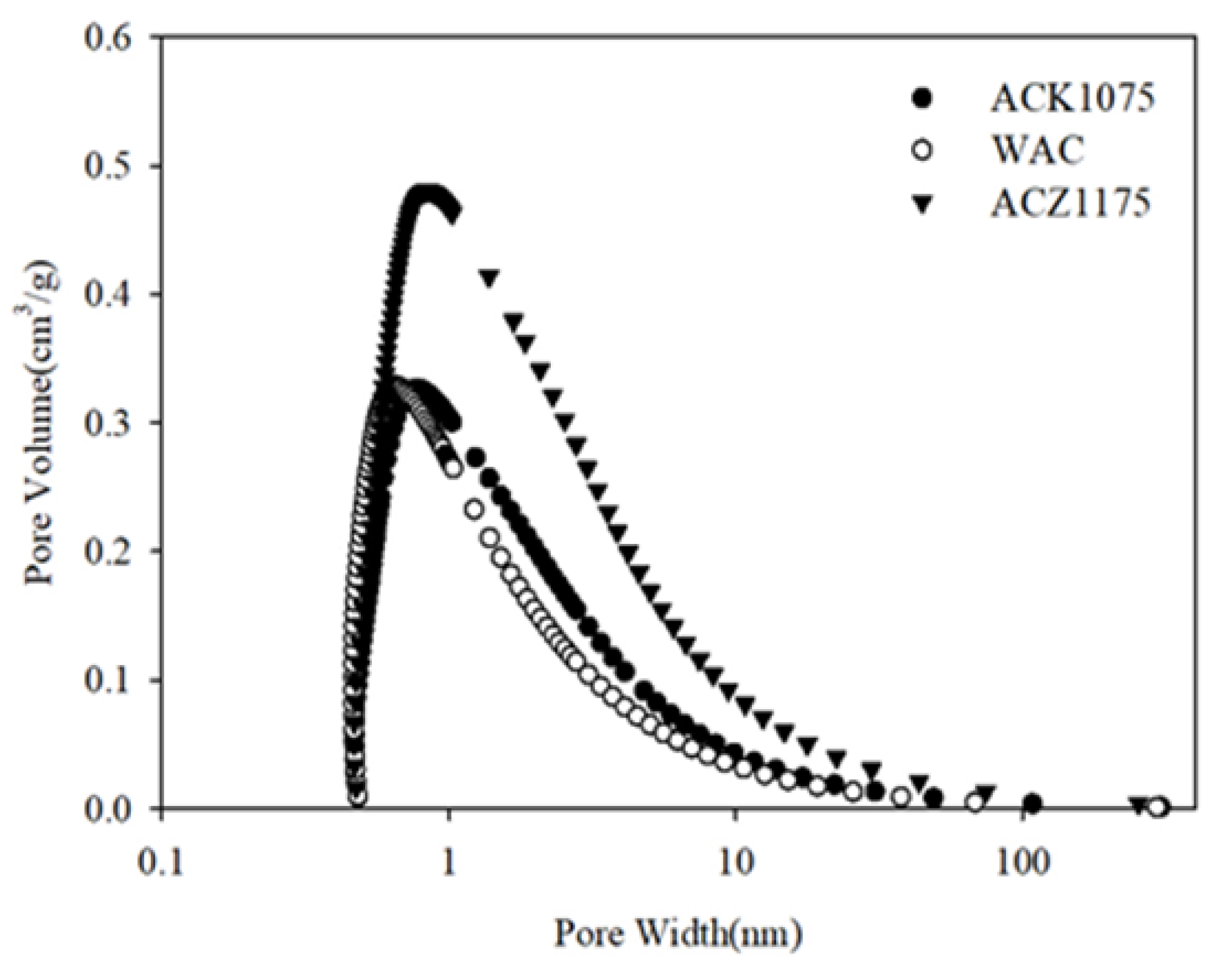
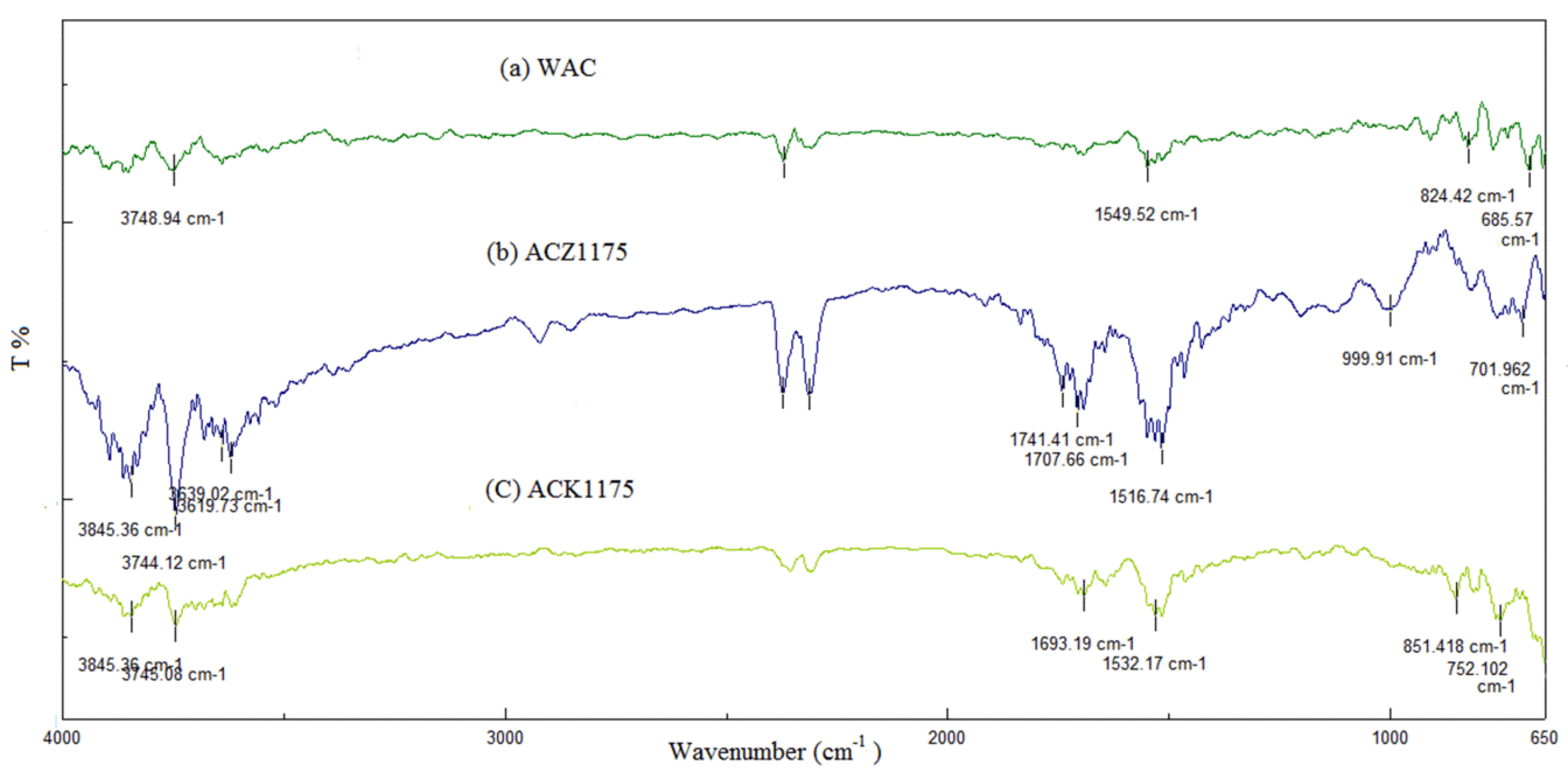
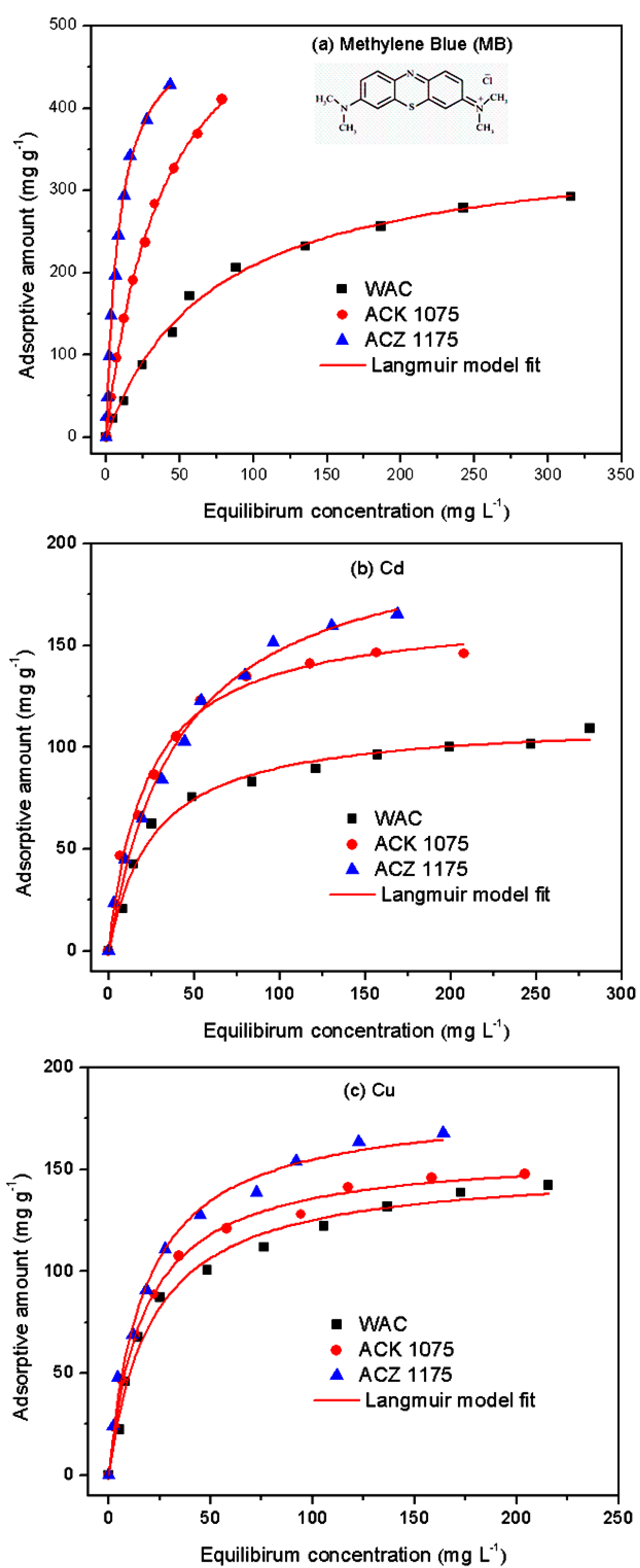
| Sample | BET Surface Area | Pore Volume | Average Pore Size |
|---|---|---|---|
| (m2 g−1) | (cm3 g−1) | (nm) | |
| WAC | 792 | 0.34 | 1.74 |
| ACZ1175 | 1757 | 1.02 | 2.34 |
| ACK1075 | 1013 | 0.42 | 1.65 |
| Sample | Atomic Concentration of Elements by XPS (At%) | ||||
|---|---|---|---|---|---|
| C | O1s | K | Zn | Cl | |
| WAC | 90.31 | 9.69 | - | - | - |
| ACZ1175 | 91.32 | 7.55 | - | - | 0.17 |
| ACK1075 | 85.72 | 13.8 | 0.49 | - | - |
| Sample | Acidic Groups (mmol/g) | |||
|---|---|---|---|---|
| Carboxylic | Alcoholic | Phenolic | Total | |
| WAC | 0.54 | 0.72 | 0.38 | 1.64 |
| ACZ1075 | 0.83 | 0.82 | 0.40 | 2.05 |
| ACZ1100 | 0.94 | 0.84 | 0.41 | 2.19 |
| ACZ1125 | 1.11 | 0.97 | 0.42 | 2.50 |
| ACZ1175 | 1.21 | 1.04 | 0.45 | 2.70 |
| ACZ1200 | 1.08 | 0.92 | 0.44 | 2.44 |
| ACK1075 | 0.92 | 081 | 0.43 | 2.16 |
| ACK1100 | 0.88 | 0.90 | 0.37 | 2.15 |
| ACK1125 | 0.84 | 0.78 | 0.44 | 2.06 |
| ACK1175 | 0.81 | 0.88 | 0.36 | 2.05 |
| ACK1200 | 0.83 | 0.81 | 0.40 | 2.04 |
| Sample | KL | b | R2 |
|---|---|---|---|
| (L mg−1) | (mg g−1)/(mmol g−1) | ||
| WAC | 0.0138 | 360/1.13 | 0.995 |
| ACZ1075 | 0.0117 | 503/1.57 | 0.984 |
| ACZ1100 | 0.0148 | 536/1.68 | 0.993 |
| ACZ1125 | 0.0219 | 569/1.78 | 0.978 |
| ACZ1175 | 0.0250 | 614/1.92 | 0.985 |
| ACZ1200 | 0.0863 | 576/1.80 | 0.991 |
| ACK1075 | 0.1112 | 516/1.61 | 0.994 |
| ACK1100 | 0.0910 | 509/1.59 | 0.985 |
| ACK1125 | 0.1236 | 494/1.54 | 0.975 |
| ACK1175 | 0.0986 | 493/1.54 | 0.984 |
| ACK1200 | 0.1032 | 499/1.56 | 0.986 |
| Sample | KL | b | R2 |
|---|---|---|---|
| (L mg−1) | (mg g−1)/(mmol g−1) | ||
| WAC | 0.037 | 113/1.01 | 0.987 |
| ACZ1075 | 0.042 | 156/1.39 | 0.997 |
| ACZ1100 | 0.048 | 164/1.46 | 0.991 |
| ACZ1125 | 0.014 | 182/1.63 | 0.982 |
| ACZ1175 | 0.024 | 208/1.86 | 0.992 |
| ACZ1200 | 0.018 | 174/1.55 | 0.983 |
| ACK1075 | 0.045 | 166/1.48 | 0.992 |
| ACK1100 | 0.045 | 159/1.42 | 0.974 |
| ACK1125 | 0.066 | 158/1.41 | 0.976 |
| ACK1175 | 0.075 | 164/1.46 | 0.982 |
| ACK1200 | 0.034 | 162/1.45 | 0.984 |
| Sample | KL | b | R2 |
|---|---|---|---|
| (L mg−1) | (mg g−1)/(mmol g−1) | ||
| WAC | 0.048 | 151/2.30 | 0.989 |
| ACZ1075 | 0.031 | 158/2.49 | 0.966 |
| ACZ1100 | 0.041 | 162/2.55 | 0.967 |
| ACZ1125 | 0.048 | 172/2.71 | 0.968 |
| ACZ1175 | 0.056 | 182/2.87 | 0.991 |
| ACZ1200 | 0.062 | 176/2.77 | 0.982 |
| ACK1075 | 0.057 | 159/2.48 | 0.991 |
| ACK1100 | 0.044 | 156/2.46 | 0.988 |
| ACK1125 | 0.037 | 154/2.43 | 0.976 |
| ACK1175 | 0.047 | 155/2.44 | 0.992 |
| ACK1200 | 0.031 | 152/2.39 | 0.978 |
| Raw Material | Process | Production Temperature/Time | Target Sorbate | Adsorption Mechanism | Adsorption Capacity Q0max | Reference |
|---|---|---|---|---|---|---|
| Factory-rejected tea (FTR) | 1st: Hydrothermal carbonization (HTC) | 200 °C, 5 h | Methylene blue (MB) | The hydrochar-to-NaOH ratio plays a role in the surface structure of AC. Provided the best textural characteristics with diverse functional groups. | 487.4 mg/g | [40] |
| 2nd: Impregnated by NaOH | 800 °C, 1 h | |||||
| Bamboo | 1st: Hydrothermal carbonization (deionized water and HCl 1 M). | 200 °C, 24 h | Methylene blue (MB) | The surface area and pore volume of hydrochar produced in acid medium was large and NaOH treatment of as-produced hydrochar can enhance the oxygen-containing functional groups on its surface. | 655.7 mg/g of modified hydrochar compared to 268.9 mg/g of original hydrochar | [43] |
| 2nd: Mixture between 1 g of hydrochar samples, 0.25 M 100 mL NaOH | Room temperature, 1 h | |||||
| Vegetables such as prickly pear peels—CarTuna, white sapote seeds—CarZapQ, and broccoli stems— CarBrocQ. | 1st: The impregnation ratio of vegetable residue/H3PO4 (w/w). | Room temperature, 24 h | Methylene blue (MB) | Introduction of a large specific surface area and high total pore volume with average pore size. Additionally, the presence of anionic and cationic functional groups, found by means of FTIR, confers the carbons the ability to adsorb MB. | Maximum adsorption capacities of CarZapQ, CarTunaQ, and CarBrocQ for MB were 277.8, 416.7, and 500.0 mg/g, respectively. | [41] |
| 2nd: Pyrolysis | 400 °C, 3 h | |||||
| Teak (Tectona grandis) sawdust | 1st: Teak sawdust-hydrochar | 190 °C, 24 h | Methylene blue (MB) | Increasing amount of oxygen-containing functional groups is regarded as an important factor in determining the adsorptive amounts. Electrostatic force is the primary adsorption mechanism for the contaminants tested. The complexation reaction is a vital adsorption mechanism for Cu2+. Other mechanisms are less important in the adsorption of MB and Cd2+. | ACZ1175: 614.0 mg/g ACK1075: 516.0 mg/g | This study |
| 2nd: AC samples synthesized by chemical activation K2CO3 (ACK1075) or ZnCl2 (ACZ1175) in various weight ratios. | 800 °C, 4 h | Cadmium (Cd2+) | 208.0 mg/g for ACZ1175 and 166.0 mg/g for ACK1075 | This study | ||
| Copper (Cu2+) | 182.0 mg/g for ACZ1175 and 159.0 mg/g for ACK1075 | This study | ||||
| Coconut shells | 1st: Hydrothermal carbonization | 200 °C, 2 h | Methylene blue (MB) | Presence of carbon-rich hydrochar with a high yield of 77% and an oxygen-group-enriched structure was produced through hydrothermal carbonization | 200.0 mg/g | [42] |
| 2nd: Impregnated by NaOH for 4 h. Activated by heating in a horizontal tubular stainless-steel reactor. | 600 °C, 1 h | |||||
| Sawdust, wheat straw, and corn stalk | 1st: HTC | 200 °C, 20 h | Cadmium (Cd2+) | KOH modification of hydrochars might have increased the aromatic and oxygen-containing functional groups, such as carboxyl groups. | Increasing the sorption capacity of Cd (30.4–40.7 mg/g) | [39] |
| 2nd: Impregnated by 500 mL of 2 M KOH | Room temperature, 1 h | |||||
| Pitch-based carbon fibers | 1st: Pyrolysis (denoted as ACFs) | 900 °C, 0.5 h | Copper (Cu2+) | Increasing the formation of functional groups without damage to the fiber surface. The adsorption capacity of Cu2+ and Ni2+ is mainly influenced by the quantity of lactone groups on the carbon surface at pH < pHzpc and by the amount of acidic functional groups at pH > pHzpc. | 32.2 and 11.2 mg/g of ACF15-HNO3 for Cu2+ and Ni2+, respectively. 26.8 and 10.2 mg/g of ACF15-NaOH for Cu2+ and Ni2+, respectively | [38] |
| 2nd: Modification of ACFs with HNO3 (1 M) and NaOH (1 M) | Boiling temperature, 2 h. | Nickel (Ni2+) |
© 2019 by the authors. Licensee MDPI, Basel, Switzerland. This article is an open access article distributed under the terms and conditions of the Creative Commons Attribution (CC BY) license (http://creativecommons.org/licenses/by/4.0/).
Share and Cite
Duy Nguyen, H.; Nguyen Tran, H.; Chao, H.-P.; Lin, C.-C. Activated Carbons Derived from Teak Sawdust-Hydrochars for Efficient Removal of Methylene Blue, Copper, and Cadmium from Aqueous Solution. Water 2019, 11, 2581. https://doi.org/10.3390/w11122581
Duy Nguyen H, Nguyen Tran H, Chao H-P, Lin C-C. Activated Carbons Derived from Teak Sawdust-Hydrochars for Efficient Removal of Methylene Blue, Copper, and Cadmium from Aqueous Solution. Water. 2019; 11(12):2581. https://doi.org/10.3390/w11122581
Chicago/Turabian StyleDuy Nguyen, Hai, Hai Nguyen Tran, Huan-Ping Chao, and Chu-Ching Lin. 2019. "Activated Carbons Derived from Teak Sawdust-Hydrochars for Efficient Removal of Methylene Blue, Copper, and Cadmium from Aqueous Solution" Water 11, no. 12: 2581. https://doi.org/10.3390/w11122581
APA StyleDuy Nguyen, H., Nguyen Tran, H., Chao, H.-P., & Lin, C.-C. (2019). Activated Carbons Derived from Teak Sawdust-Hydrochars for Efficient Removal of Methylene Blue, Copper, and Cadmium from Aqueous Solution. Water, 11(12), 2581. https://doi.org/10.3390/w11122581






